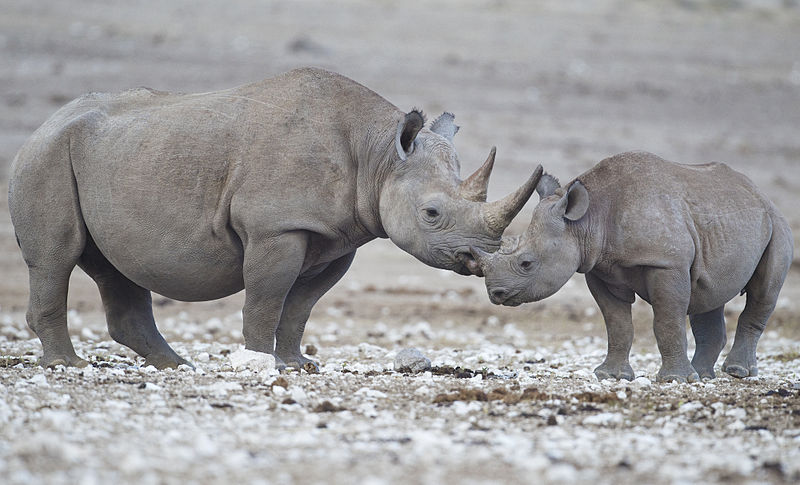When you travel the world in a private jet to catch a glimpse of some of the world’s most precious wildlife during a safari, there isn’t always a guarantee that you’ll see them before you have to go home. The Journey to Nature’s Edge expedition by Natural World Safaris is different. During an epic trip to 12 destinations across the globe, you will take your time in seeing 18 of the planet’s most vulnerable species with the help of the best local guides, who will also teach you about the region’s conservation efforts. A portion of the proceeds that the tour company earns is donated to the Convention on International Trade in Endangered Species of Wild Fauna and Flora and various conservation projects.
Animals that You’ll See
• Northern white rhino: Native to eastern and central Africa, northern white rhinos have distinctive square lips. While they are part of the largest extant species of rhinoceros (white rhinos), there were only three remaining animals in the subspecies in 2015. You can see the critically endangered animals at Kenya’s Ol Pejeta Conservancy, protected by armed guards.
• Black rhino: Native to eastern and southern Africa, black rhinos have distinctive hooked lips. The critically endangered mammals’ biggest threats include poaching, competing species and habitat changes. Just over 2,000 black rhinos remain in the world. You will find them in Namibia during your trip.
• Mountain gorilla: A subspecies of the eastern gorilla, the mountain gorilla population is critically endangered. At the time of publication, about 880 gorillas remain in Africa’s dense cloud forests. The greatest threats include habitat losses, poaching, war and diseases. Your tour will take you to a Rowandan sanctuary to see the primates in a protected habitat.
• Chimpanzee: Native to forested regions in sub-Saharan Africa, chimps are the only extant exclusively African species of great ape. The U.S. Fish and Wildlife Services listed the apes (wild and captive) as endangered in 2015. There are about 150,000 wild chimpanzees throughout Africa. You will get an up-close look at the Jane Goodall Institute in Tanzania.
• Black-and-white ruffed lemur: Found in eastern Madagascar, humans and agricultural practices are the largest threat to black-and-white ruffed lemurs. The animals are best known for their loud choruses and rare female social dominance.
• African wild dog: Native to sub-Saharan Africa, African wild dogs are the only member of the Lycaon genus. The highly social animals are endangered due to human persecution, diseases and habitat fragmentation. One of the best places to see wild dogs is in Botswana.
• Bengal tiger: Native to India, Bangladesh, Nepal and Bhutan, there were fewer than 2,500 Bengal tigers remaining in the world in 2011. Poaching and human-tiger conflicts led to population declines. During your trip, you’ll see them in India.
• Snow leopard: Native to south and central Asia, there are up to 8,700 snow leopards remaining in the world at the time of publication. Global warming decreased in the wild cats’ prey, contributing to the decline in populations. You will see snow leopards during a trip to India.
• Orangutan: Exclusive to Asia, orangutans are the only surviving species of the Ponginae subfamily. They are also the most arboreal and solitary of the great apes. Bornean and Sumantran orangutans are critically endangered, while other subspecies are endangered due to forest fires, logging, agriculture and poaching. During your trip, you will see them in Borneo.
• Borneo pygmy elephant: Found in Borneo, Malaysia and Indonesia, the baby-faced elephants are genetically different from other Asian elephant species. About 1,500 of the endangered subspecies exist at the time of publication. You can see the unique creatures at rehabilitation centers in Borneo.
• Sun bear: Native to southeast Asia, the sun bear population is considered vulnerable because of deforestation and commercial hunting. The bears do not hibernate and primarily eat honey, insects and fruit. During your worldwide safari, you’ll see them in Borneo.
• Green and hawksbill turtles: Found in Borneo, hawksbill turtle and green turtle swim in the waters of the Atlantic and Pacific Oceans. The hawksbill turtle has a more prominent beak, while the green turtle has larger paddle-like flippers. About 20,000 female hawksbill turtles remain, making them critically endangered. While there is a larger green turtle populace, the declining population makes them endangered.
• Jaguar: The only extant Panthera species native to the Americas, jaguars live in the southwestern U.S., throughout Central America, and as far south as Argentina. Threats include loss of habitat and conflicts with ranchers. You can get a unique view of the world’s third largest cat in Brazil.
• Polar bear: Found in the Arctic Circle, polar bears and their 19 subpopulations are a vulnerable species due to habitat losses caused by climate change. Up to 31,000 polar bears remain on the planet. On your worldwide tour, you’ll see them in Canada.
• Giant tortoise: Found exclusively on Ecuador’s Galápagos Islands, giant tortoises weigh up to 920 pounds and live up to 250 years. About 14 subspecies of the tortoise exist on the distinct islands. As little as 250 years ago, about 20 species and subspecies existed.
• Waved albatross: The only species of the Diomedeidae family that lives in the tropics, waved albatross migrate from Peru to the Galápagos Islands each year. The critically endangered birds have a wingspan of seven to eight feet, long yellow bills and blue feet. There were about 34,700 breeding pairs in 2001.
• Penguins: Aquatic, flightless birds, penguins live in the southern hemisphere, in warm and cold climates. While penguins in general are not endangered, some of the 20 living subspecies are threatened. On a trip to Whichaway Camp in Antarctica, you’ll see majestic emperor penguins in their natural habitat.
Accommodation Options
• Solio Lodge
• Virunga Lodge
• Nomads Greystoke Camp
• Vakona Forest Lodge
• Setam Lodge
• Zafara Camp
• Hoanib Camp
• Whichaway Camp
• Mahua Kothi Lodge
• Banjaar Tola Lodge
• Sepilok Nature Resort
• Myne Resort
• Lankayan Island
• Borneo Rainforest Lodge
• M/Y Grace
• Southwild Jaguar Flotel
• Seal River Heritage Lodge

